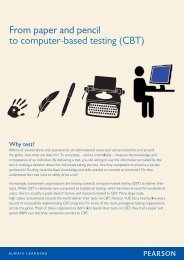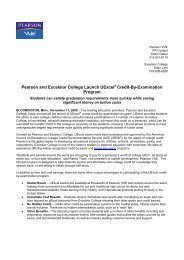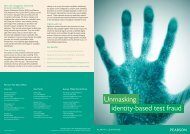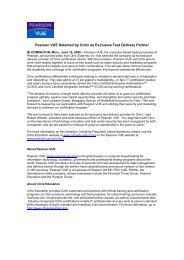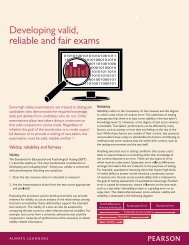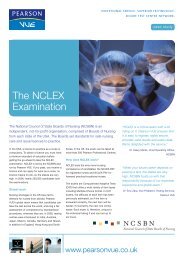Security_matters - Pearson VUE
Security_matters - Pearson VUE
Security_matters - Pearson VUE
Create successful ePaper yourself
Turn your PDF publications into a flip-book with our unique Google optimized e-Paper software.
<strong>Security</strong> <strong>matters</strong><br />
There will always be a group of individuals who make increasingly<br />
sophisticated attempts to cheat exams. Whether it’s to advance their own<br />
career or to make money by assuming the identity of a registered candidate,<br />
a minority pursue certification using unethical and illegal means.<br />
It is for this reason why robust security measures are essential to<br />
safeguarding the integrity of your programme and business.<br />
<strong>Security</strong> focussed: <strong>Pearson</strong><br />
<strong>VUE</strong>’s Mark Poole<br />
The three groups<br />
Those who attempt to compromise certification exams can be split into three groups: proxy test<br />
takers, item harvesters and cheaters.<br />
Proxy test takers go to a test centre to sit an exam registered as another individual. An item harvester<br />
is someone who takes an exam under their real name, but their sole intention is to steal intellectual<br />
property. The worst offenders in this category are those working for black market test vendors or<br />
other organisations who believe they can profit from stealing test questions. A less sinister item<br />
harvester is someone who uses a brain dump site to prepare for the exam and returns to the site to<br />
post several items that he/she remembers to "give back" to the group. Cheaters are individuals who<br />
are not trying to profit by stealing intellectual property but are simply dishonest people willing to cheat<br />
to pass an exam.<br />
Data protection and security<br />
<strong>Security</strong> begins with smart test design. You can take advantage of capabilities to deter item theft and
track exposure by using tools such as randomisation, complex item types and item masking. In addition<br />
to sophisticated security measures, our infrastructure features strong encryption, item-at-a-time<br />
presentation and an electronic audit trail to prevent exam fraud and data theft before, during and after<br />
exam delivery.<br />
Secure proctored delivery<br />
<strong>Pearson</strong> Professionals Centres (PPCs) are built to a patented security design featuring the highest level<br />
of security with the highest proctor-to-test-taker ratio in the industry. PPCs and many of our<br />
authorised partners use digital audio and video surveillance to deter and record any misconduct during<br />
the testing process. Real-time incident reports submitted by test centre proctors and customer service<br />
personnel are automatically linked to test-takers’ individual records for prompt investigation and<br />
escalation.<br />
Global identity management<br />
By enforcing your programme’s unique business rules and ensuring only properly identified test-takers<br />
are able to sit for your exams, we protect your content and reduce the risk of fraud. A unique<br />
scheduling and test centre check-in process automatically enforces your authorisation and retake rules<br />
and ensures all required identification procedures are correctly followed.<br />
Palm vein<br />
Traditionally, computer-based testing centres have used photo-matching and digital fingerprinting to<br />
determine candidate identity. At <strong>Pearson</strong> <strong>VUE</strong>, we’ve taken this one step further by using palm vein<br />
recognition. The device captures and recognises the unique patterns in a candidate's palm veins using<br />
non-intrusive, near-infrared scanning technology. New candidates are enrolled on the biometric system<br />
during their first test centre admission. They are then automatically verified when taking and returning<br />
from breaks. Palm vein recognition has proven secure, privacy friendly, fast and highly accurate. The<br />
technology has replaced photo-matching and digital fingerprinting to become the most reliable<br />
biometric technology for candidate identification.
Compliance management<br />
The ability to successfully leverage business intelligence and enforce compliance can make a difference<br />
to your entire programme. Our compliance management capabilities and optional forensic services<br />
ensure you remain in control of test security. Our global security team continuously monitors testing<br />
activity, evaluates risks, investigates potential irregularities and initiates corrective action when<br />
required.<br />
Despite the sophistication of our security measures, we also rely on our test centre staff to identify<br />
issues and cases on attempted fraud. Earlier in the year, staff at one of our UK test centres caught<br />
three candidates who were attempting to cheat an exam using Bluetooth devices. All three candidates<br />
were using the devices to receive voiceovers and attempted to distract the invigilator by calling them<br />
over. As the invigilator walked away from the test station, another member of staff observed the<br />
candidates on camera and noticed them slipping the devices into their headset. Our teams around the<br />
world share experiences such as these to ensure all regions are informed of the latest fraudulent<br />
attempts and schemes. By using a combination of knowledge sharing, leading technology, vigilant and<br />
regularly trained staff, we are able to maintain the world’s largest secure test centre network and,<br />
crucially, protect the prestige and reputation of our clients.<br />
Our knowledge and awareness of security is heightened by the clients we serve. We deliver a number<br />
of security certification programmes on behalf of clients around the globe, such as Check Point, RSA<br />
<strong>Security</strong> and BCS, The Chartered Institute for IT.<br />
Mark Poole, Product Strategist and <strong>Security</strong> Expert, <strong>Pearson</strong> <strong>VUE</strong>



